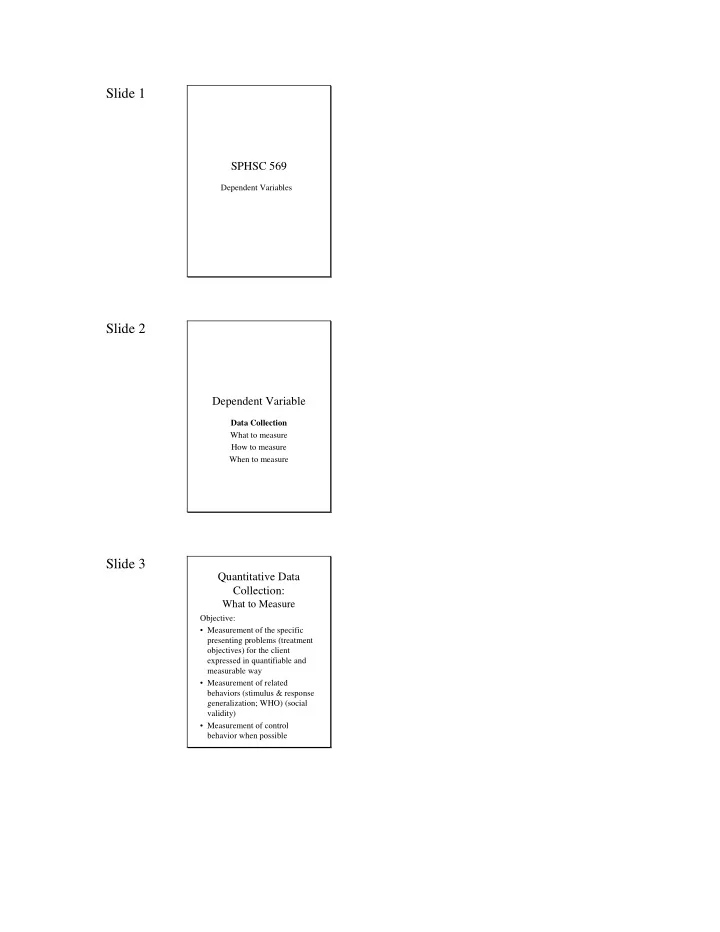

Slide 1 SPHSC 569 Dependent Variables Slide 2 Dependent Variable Data Collection What to measure How to measure When to measure Slide 3 Quantitative Data Collection: What to Measure Objective: • Measurement of the specific presenting problems (treatment objectives) for the client expressed in quantifiable and measurable way • Measurement of related behaviors (stimulus & response generalization; WHO) (social validity) • Measurement of control behavior when possible
Slide 4 Guidelines for Collecting Data: What to Measure • Select measures that are both sensitive, meaningful, and accurate – consider psychometric properties validity and reliability – consider social validity (Schwartz & Baer; Wolf) • Normative Comparison • Relevant Peer Comparison • Subjective Evaluation (consumers) Slide 5 Types of Measures • Probe Measures – Target – Generalization – Control • Treatment Measures Slide 6 Types of Data/Measures (Quantitative and Qualitative Data) • Physiological Data • Self (Other)-Report Data • Observational Data
Slide 7 Physiological Data Date involving instrumentation Issues: • Feasibility-costs, standardization • Organism variables (age, sex, physical fitness, drug use etc.) • Stimulus/situational variables • Examples Slide 8 Self (Other)-Report Data • Interview (client/other retrospective, client/other current, clinician observation during interview) – Unstructured interviews – Semi-structured interviews • Issues associated with the interview – Style/traits of interviewer – Style/traits of respondent Slide 9 Self (Other)-Report Data • Questionnaires/Rating Scales – Broad questionnaires – Specific questionnaires – Measures of client (others) satisfaction – Self-ratings – Informant Reports • Issues in Self (Other)-Report – Stimulus variables – Organism variables – Design variables (construction of questionnaire/rating scales)
Slide 10 Observational Data Direct observation and self- monitoring • Observational Quantitative Data – Frequency – Time Based (duration) – Interval (Sulzer-Azaroff & Mayer Handout) Slide 11 Observational Data • Issues – Sources of Bias • Observer characteristics (gender, expectation) • Reactivity • Observer drift (consensual) • Complexity of rating system and behaviors to be coded (including valence) • Sampling method • Ecological variables • Observational medium Nature of training (reliability) Slide 12 Guidelines for Collecting Data: How to measure • Collect data under the same/similar conditions across time--conditions of data collection • Consider along a continuum – Manner of collection (sampling technique) – Setting/situation of collection – Individuals involved in collection – Obtrusiveness/reactivity of collection (Handout)
Slide 13 Data Collection: When/How Often Four Main Considerations • Change due to treatment versus maturation (or other threats to validity) – Multiple measures (control) • Change that is real versus random • Importance of change – Degree of change, rate/slope of change • Impact of change – Social validity measures Slide 14 Guidelines for Collecting Data: When/How often to measure • Collect measures often, periodically and systematically (How often is enough?) (How often is feasible?) – Weekly – Every two/three weeks – Monthly • Consider your research question (e.g., ultimate versus instrumental versus intermediate change) Slide 15 Guidelines for Collecting Data: When/How often to measure • Record inconvenient measures less frequently than more convenient measures • Keep track of significant events (anticipated or not) that might account for alterations in or variability in performance • Consider client reaction to measurement • Graph the data (including the significant events)
Slide 16 Guidelines for Collecting Data: When/How often to measure • Collect often enough to see change (be mindful of phase changes) • Follow major treatment breaks – Completion of a treatment step – Completion of particular treatment criterion – Intersperse during treatment Slide 17 When to Measure Change BOTTOM LINE: • What is reasonable • What will best allow me to monitor progress • What will best reflect (and prove) change Slide 18 Dependent Variables • Examples
Recommend
More recommend